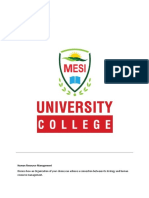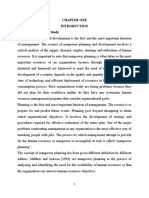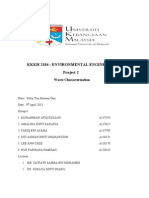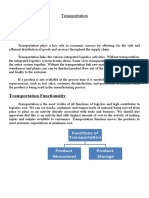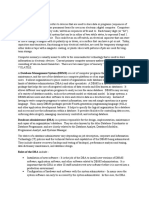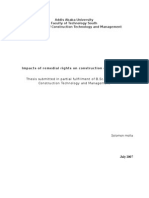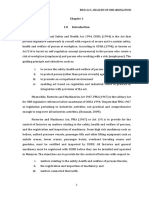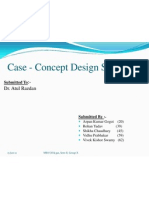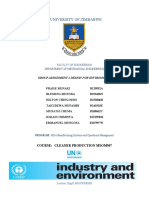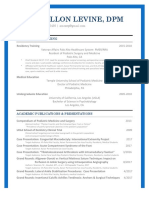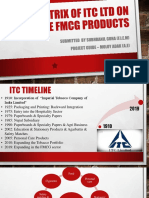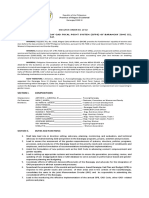Final Report
Final Report
Uploaded by
Rozita SedekCopyright:
Available Formats
Final Report
Final Report
Uploaded by
Rozita SedekCopyright
Available Formats
Share this document
Did you find this document useful?
Is this content inappropriate?
Copyright:
Available Formats
Final Report
Final Report
Uploaded by
Rozita SedekCopyright:
Available Formats
Page |1
1.0
Company Background Shell is a global group of energy and petrochemicals companies with around 101,000 employees in more than 90 countries and territories. The innovative approach ensures it is ready to help tackle the challenges of the new energy future. In year 1891, Shell has been active in
Malaysia. Shell business activities in Malaysia include Upstream International, Downstream, and projects & technology. In addition, Shell has also established several hub businesses in Malaysia, which provide services and expertise to the Asia Pacific region and, in some cases, globally.
In 19 January 2010, projects and technology is officially launched which provides technical services, technology capability and helps facilitate major project delivery to both the Upstream and Downstream businesses. The Upstream and Downstream business in Malaysia are as shown below:. Upstream Business
y y y y y y y y
Downstream Business
y y y y y y y y
Exploring for oil and gas Developing fields Producing oil and gas Mining oil sands Extracting bitumen Liquefying gas and regasifying Converting gas to liquid products Generating wind energy
Rening oil into fuels and lubricants Producing petrochemicals Developing biofuels Trading Retail sales Managing CO2 emissions Supply and distribution Business-to-business sales
In addition, Shell delivers differentiating technical information technology (IT) for Shell and drives research and innovation to create technology solutions for tomorrow. With over 8,200 professionals worldwide, the ability to deliver fully integrated solutions by combining third-party capability with our proprietary technology and technical capability standards makes us an attractive partner of choice
Page |2
for our stakeholders and potential partners. Our ability to leverage effective contracting and procurement processes is vital to success across the Group and enables us to deliver an efficient and cost-effective service.
P&T in Malaysia houses 700 professionals, many of whom have extensive operations and technical experience across all technical disciplines. Malaysia is one of the seven main P&T hubs and is seen as the key driver to drive Shells agenda of growing the business in this part of the region. The P&T offices in Malaysia are mainly located in Tower 2, PETRONAS Twin Towers and eTiqa Twin. P&T also oversees safety and environment performance for the Group.
In July 2008, the Shell Business Service Centre Malaysia operations construct was introduced with the primary objective of bringing together the various established shared service operations. The Shell Business Service Centre Kuala Lumpur is one of six global business service centers providing finance, accounting, human resource, customer service, contracts and procurement services and information technology to Shell operating companies globally. These centers enable the delivery of common business operations and services for Shell at world-class operational excellence.
Shell is going to concentrate more on contracts and procurement services. Contracts and procurement (CP) helps ensure standardization in the efficient management of monetary resources. CP supports Shell operations and capital projects by guaranteeing timely delivery of goods and services to the right specification.
On the other hand, Shell also focuses on the employees and contractors health to ensure everyone is fit to perform their duties. Steps taken by Shell to manage employees health are as shown below:
y
Medical evaluation for fitness to work as required by Shell and local authorities.
Completion of Health Risk Assessment for the whole refinery to identify all potential health associated risks.
Provision of doctors to provide medical emergency services throughout the year.
Page |3
2.0
Literature Review According to Rynes, 1991; Rynes and Cable (2003), human resource
recruitment is involves the utilization of organizational practices to influence the number and types of individuals who are willing to apply for job vacancies. The importance of recruitment process is not same due to the different strategic among organization. All the organizations are required to make decision in three areas of recruiting: personal policies, recruitment sources used to solicit applicants and characteristics of recruiters (Raumond, John, Barry and Patrick, 2010). On the other hand, according to Jones, David A., Shultz, Jonas W., Chapman, and Derek S. (2006), recruitment is known as central to any management process. Any failure in recruitment can create difficulties for any organizations including an adverse effect on its profitability and inappropriate levels of staffing or skills. Human resource imbalance can lead to labor shortages or surplus, or problems in management decision making.
In most organizations, there are two outlets of recruitment; internal and external recruitment. Internal recruitment occurs when a position opens for the existing employees in an organization. For internal recruitment, the positions will be posted on the organizations intranet and in common areas, such as cafeterias. If an existing employee is interested in the position, he or she is normally required to go through a similar process as an external candidate (Lucy Friend, n.d.).
On the other hand, external recruitment occurs when the organization looks to fill the vacancy from any suitable applicants outside organizations (Tommy Doan, n.d.). The external recruitment will increase the popularity of the organization on the job market, which helps to improve the position for further expansion. However, it is expensive and takes a lot of energy from the human resource department to handle all the candidates in the selection process (HRM Advice, 2008).
According to Zottoli and Wanous (2000), there are several sources for external recruitment like employment advertising, employee referral programs, job fairs, college campus recruitment, rehiring former employees, employment agencies or
Page |4
networking. Among these methods, the employment advertising is the most common form of external recruitment. They can be found in many places such as newspaper, job posting on job sites and advertisement on websites related to positions recruited (Tommy Doan, n.d.).
In a complete recruitment process, it can be broken into seven steps. Each of these steps contains a specific function that has a number of decisions. The factors that affect those decisions include: size of business, type of position and resources available. Each company must decide what suits them. Those seven steps are as shown below: document and needs analysis for opening, creating recruiting plan, defining and using available resources to find candidates, screening candidates, interviewing, selection and hiring (staffing-and-recruiting-essentials-com, 2008).
An interview is to determine whether an applicant is suitable for a position of employment offered by an organization. According to Dun and Bradstreet Credibility Corp., there are a few things that should be done to conduct an effective employee interview. If you can ask the right questions, you're more likely to select a candidate who's right for the job. Interviewer has to be a good listener; need to know how to redirect a conversation; and able to make a distinction between those who simply want the job and the perfect candidate who can get the job done. The following are some guidelines to conduct a successful interview. a) Prepare - Review a candidate's paperwork prior to the interview. Reviewing a resume in front of the interviewee is rude and shows poor preparation. b) Set the tone - Let your candidates know that you're glad to meet them. Explain how the interview will proceed and then try to follow that format as closely as possible. c) Prepare a script - Your human resources department may even have a set of prepared questions to use as a guide. Ask a good mix of questions that give insight into the candidates behavior, opinion, experience, and background. d) Know what is required - If the interviewer does not know the skill required for the open position, he or she might not ask the right questions, which may confuse the candidate.
Page |5
e)
Manage time wisely Interviewer should stick to the schedule as much as possible. Do not waste time on unsuitable candidate.
f)
Write it down - Take notes during the interview so that it can be reviewed at a later time. This will be especially important if there are many candidates interviewing for the position.
Interviewer should also be conscious of the impressions they are making as well. Just as the interviewee is selling him or herself to the company, the interviewer is basically trying to achieve the same result. Therefore, interviewer must know as much as possible about his or her company; because the interviewee will be looking to them to provide that information (Dun and Bradstreet Credibility Corp., n.d.). 3.0 Recruitment Process In Shell, there are two ways of recruiting process; either via internal or external resource. Internal resource means the job opening will be filled up by current Shell employee whereby external resource means the job will be filled up by someone from outside Shell. External resource can also refer to contractors that are currently working for Shell who were contracted via third party.
Shell values long-term employment relationships. They help employees develop their skills and enhance their careers. As such, normally, when there is a vacancy, Shell Hiring Manager is required to open the opportunity to Shell internal employee before he or she can open it to the external resources. This is to allow Shell internal employee be a given a chance for career adv ancement/promotion or career movement in order to enhance their work exposure in their career development. However, Shell Hiring Manager is allowed to bypass the requirement to open up the vacancy to Shell internal employee if the position required someone with a special skill (niche market) or if the position is project based and crucial to the development and progress of the project. This can be done with a business case write up accompanied by certain exceptional approval from Central Human Resource Manager. The overview recruiting process of Shell is as shown in figure below.
Page |6
Recruiting Process
Internal Recruitment
External Recruitment
Sourcing Process 3.1 Internal Recruitment
Screening Process
Interview Process
For internal recruitment process, the Hiring Manager would post up the vacancy in the Shell System called Open Resource. The duration for the posting must be at least two weeks before the Hiring Manager can proceed with external recruitment. Sometimes, Hiring Manager would post the vacancy twice in the Open Resource in order to give more chance and time to Shell internal employee to take the job. Once the posting is closed, the Hiring Manager would do a screening on the employees resume and past Goal Performance Appraisal documents. If there is suitable candidate, the Hiring Manager would then carry out a telephone interview. After that, the Hiring Manager would select the best candidate and offer the job to the candidate. Once the employee accepts the offer, it would then be passed to Human Resource department to negotiate on the effective date and make the changes in the system in terms of reporting line and also the salary if it is a career advancement or promotion.
Shell prefers to use internal recruitment compared with external recruitment. The advantage of using internal recruiting is that considerable savings can be made. Individuals with inside knowledge of how a business operates will need shorter periods of training and time for 'fitting in'. Most importantly, the organization is unlikely to be greatly 'disrupted' by someone who is used to working with others in the organization. From Shells point of view, the strengths and weaknesses of an insider will have been assessed. There is always a risk attached to employing an outsider who may only be a success 'on paper'. Furthermore, the existing employee is already familiar with the Shell vision, objectives and core values. Therefore, the
Page |7
hiring manager will save quite a lot of time and resources if he or she chooses the existing employee to fill up the vacancy.
The career development is a huge benefit of the internal recruitment process. The career development has to be communicated openly and the employees cannot be worried about their application for a new position within the organization. The career development can define special rules for the application for the new position. The rule is usually about the necessity to stay at one position for a defined period of time before applying for a new one. Internal recruitment could also be a great way of keeping workers who may have been considering a flight from the company, this is advantageous because the cost of training are at most best insignificant and to the worst much less than it would cost if the organization advertised outside. It is definitely faster and less costly than outside recruitment and it has the added merits because current employees are a familiar entity. Some organizations conduct external recruitment only to discover later that they have a member of staff who does not fit into the general environment and the mission and vision statement of the organization.
On top of that, internal promotion acts as an incentive to all staff to work harder within the organization. This will boost the motivation level on the employees as they see the opportunities are there for them to grab. Thus, internal recruitment can act as the promotion of their career ladder. Besides that, it gives them some sense of job security whereby there are opportunities for future career advancement in the organization. This also gives them the chance to try on different roles and experience the exhilarating exposure that is awaiting them in their future career movement. With such opportunities available for the internal employees, it can build a strong loyalty and are less inclined to look for opportunities on the external job market. Indirectly, it improves the morale of the employees. Another internal recruitment benefit is a smaller pressure for the compensation and benefits. The employees who get promoted do not press for a much higher salary for being with the organization. They take this as another milestone of their career journey. With this, it can helps organization to save some cost if they were to recruit from external resource.
Page |8
3.2
External Recruitment For the external recruitment process, the Hiring Manager is required to post up
a job requisition online via Shell recruitment system. The requisition will then flow to the Human Resource business unit for review and approval from the Human Resource Account Manager. At this stage, the Human Resource business unit will need to verify whether the internal recruitment process has been carried out prior to posting it for external recruitment.
Once the Human Resource Account Manager approves the requisition, it will then flow to the Shell Recruiter for the second review and approval for final confirmation. Shell Recruiter in this context refers to Shell employee that is from Human Resource department. Once the final approval is obtained, the Recruiter would then organize a job briefing discussion with the Hiring Manager to understand in depth the requirement for the job requisition. The discussion would normally take up an hour to complete. Once the Recruiter understands the requisition requirement, he or she will begin the sourcing process.
3.2.1 Sourcing Process Sourcing process of Shell can be divided into four methods; proactive, head hunting, advertisement and recruitment agency. Generally, Shell Recruiter would start the sourcing process with proactive method. Proactive recruiting involves networking and identifying candidates before a position is available. It reduces impulsive hiring practices and prevents prolonged vacancies in Shell.
For proactive recruiting, Recruiter will refer to the Shell recruitment database that stored the information left by interested applicants who would like to work for Shell. The information is inputted via the Shell website; www.shell.com/careers. At this website, candidates are required to fill the online application form which is designed to highlight qualities and strengths of applicants. Along with the form, candidates are asked to complete two questionnaires. The first questionnaire gives insight into life at Shell whereas the second questionnaire allows Recruiter to assess personal style and aptitude of applicants. Once the Recruiter found the suitable and
Page |9
potential candidates, he or she will start calling up the candidates to ensure whether they are interested in the job vacancy. If the candidates are interested, they will be invited for the screening process.
Another method that the Recruiter would use is the Head Hunting method. Head Hunting method means that the Recruiter will call up the potential candidates who are currently engaged by another company. Usually, the Recruiters will obtain the information of potential candidates from their friends or existing employees in Shell. However, the referrals do not receive any incentive under this method. This method is more aggressive than proactive recruiting. The advantages and disadvantages of Head Hunting method are as shown below: Advantages Disadvantages
Usually get the talents at the same Competition driving up the salaries of positions of the competitor companies. employees to unrealistic levels.
The third preferable method will be the Advertisement. Advertisement method is divided into three different types; online, print advertisement and employee referral program. For online advertisement, Shell Recruiter would either advertise the job via career website such as Jobstreets or association that is related to the job like Accountant Association, Engineering Association and others.
As for print advertisement, the job will be advertised by using the newspaper such as The Star and New Straits Times. Usually, the advertisement in newspaper will display the information about position, qualifications, skills and experiences that are required for the job. The salary of the job and detail of duties will be revealed after success in the interview process.
Another method is employee referral program. It is used by Shell to identify potential candidates from the existing employees' social networks. For this method, Shell employees can refer their friends or family to the Recruiter via the Shell recruitment system. Once the candidate that they referred is doing well during probationary period and successful to get the job, the Shell employee (referral) will be paid a certain amount of money as the incentive. Usually, the existing employees
P a g e | 10
(familiar with both the vacancy and the person they are referring) can always introduce a right person. This is because they will only refer their friends or family members when there is a fit between the person and the vacancy. Moreover, employee referral program is acknowledged as being the most cost effective to recruit candidates.
The final method of sourcing will be through the Recruitment Agency. This method is similar to the Head Hunting method. The only difference between these two methods is seeking candidates through Recruitment Agency requires Shell to pay to the Recruitment Agency to carry out the sourcing. This method is least preferred because the Recruitment Agency might not have the full understanding on the job requirement. In addition, most importantly, the fees for this method is quite costly and not that worthwhile. This method will be the last resort if all the previous three methods did not work out.
3.2.2
Screening Process After sourcing process, the screening process will be starts immediately. Shell
consists of two methods of screening; system and paper screening. In the stage of system screening, interested candidates will need to go through the knock-out questions as the first level of screening. One of the examples of knock-out questions is whether candidate is willing to work on shift or not. If he or she is willing to work on shift, then the system will lead the candidate to the second level of screening; that is self-selection questions. If the candidate is not willing to work on shift, then he or she will be knocked out immediately.
In the stage of self-selection questions, candidate is requested to answer some multi choice questions and some subjective questions that are related to working experience or skills. Once the candidate has passed the two levels in the system screening, his or her application will be reviewed for the second screening which is the paper screening. For the candidates who are not success in self-selection questions, the Recruiter will put their application to aside first. The Recruiter will refer these applications again and give an opportunity to them if there is no candidate passes the second screening.
P a g e | 11
The second screening; paper screening process is where the Recruiter would screen through the resume and curriculum vitae (CV) of the candidates. The Recruiter will evaluate the candidates according to the set of ranking methodology which is set by Shell. The ranking methodology is different for all the positions or jobs.
3.2.3 Interview Process
Shell always prefers to have the first interview via telephone as this method is more convenient for both the candidate and Recruiter. The final assessment for the shortlisted candidate after the first interview will be the face to face interview whereby candidate is requested to come to Shell Office. However, if the Hiring Manager is sitting in the other part of the world, Shell will conduct a virtual face to face interview.
For the interview process, not all Recruiter can be the interviewer. The interviewer must be either the senior management level or Recruiter that has been trained to be accredited assessor. Usually, there will be two assessor/interviewers sitting in for an interview. Both assessors will question the candidate according to the Shell methodology for interview.
Shell would normally prefer to limit its final shortlisted candidates to three persons (ideal number). Once the candidate has been selected for the job, the
assessors will then pass the result to the Human Resource business unit to proceed with the hiring. Human Resource business unit will do the benchmarking of the salary and contact the successful candidate for on boarding. To better illustrate the interview process, two examples of interviews by two current Shell employees, Rozita and Victor, are presented below.
Example 1 - Rozita
According to Rozita, she found about the vacancy in Shell from classifieds in newspapers. From the advertisement, she applied for the position of senior associate analyst in contracting and procurement department through the official Shell website. After about a week, she was contacted by Shell to take a test at the headquarters.
P a g e | 12
The test was a Native American English Test with a ninety percent passing mark. Therefore this is considered as a knock-out test. After five days Rozita took the test, she was called for an interview.
The interview was conducted by only one interviewer, the Regional Lead of Asia Pacific. In the beginning of the interview, the interviewer explained about the requirement to work in a team and asked the candidate if it was acceptable. The interview questions are structured for all candidates. Questions included the candidates personal information such as background and current employment. Besides that, situational questions are also asked to test the candidate. To create an atmosphere to test the candidates patience, the interviewer deliberately ignores and avoids eye contact with Rozita when she was providing her answers. Next, the interviewer asked Rozita to repeat the answer she had just given, or keep asking different questions that will lead to the same answer from Rozita. This not only tests the candidates patience, but also tests how the candidate will justify their answers and its consistency.
Two weeks after the interview, Rozita was shortlisted and Shell did a background check through the referees provided by candidate. Rozita was also required to undergo a medical checkup at Shell panel clinic and was given offer letter. After about one week, Rozita passed the medical checkup and was officially accepted as a Shell employee. However, if Rozita failed the test, her resume would be stored in Shell resume bank for future use.
Example 2 Victor
According to Victor, he came to know about the vacancy in Shell through referral from his social networking. The position offered is maintenance engineer in the oil movement department. He was initially required to attend a Human Resource interview. But as he was an experienced professional, he was not required to go through the interview which is solely for fresh graduates.
P a g e | 13
Therefore, when he was shortlisted for interview, the first interview he went to was conducted by three executives, namely Mechanical Engineering Service Manager, Logistics Manager, and Plant Unit Maintenance Manager. The interview is focused on the candidates experience and technical knowledge, and the questions are unstructured. According to Victor, the atmosphere was tense; the interviewers are persistent in getting more depth to the candidates answers. However, there are no tests in the interview session. The interview lasted for about one hour.
After a month, Victor was called in for a second interview because of difficulty to gather the interviewing panel at the same time to conduct the interview. The interview was conducted by three executives, the Human Resource Manager, Engineering Manager, and Maintenance Manager. The questions asked in the last interview were not repeated in this interview. However, the questions are more personal and intellectual.
There is also a pen and paper test in this interview, where the questions are situational, the candidates have to provide solutions to situations that are presented. After the test, based on the answers provided by the candidate, the interviewers discussed further with the candidate on the situational questions based on the answers provided by the candidate. The interview also lasted for about an hour like the previous one. After four weeks, Victor was contacted and was offered the position in Shell. The reason it took four weeks to finally offer the position to Victor was because two out of the three interviewers were out of town and approval cannot be done until they are back at the office.
It is evident here when the candidate is externally recruited, there is a lot of paper work and bureaucracy before the final approval can be done. This often took a lot of time and productivity may suffer as a result. This is a major weakness to a big company like Shell, where it should be dynamic and versatile to changes of the internal and external environment to stay ahead of his competitors.
P a g e | 14
4.0
Problems and Recommendations From our findings above, we realized that Shell has several areas that can be
improved in their recruitment and selection process.
4.1
Number of interviewers or assessors in an interview
It seems like the number of the interviewers or assessors varies from one interview to another. From the two examples given above, there is only one interviewer for Rozitas case and three interviewers for Victors case. For Victors case, it is not an issue because Shell methodology stated that there should be at least two interviewers or assessors in one particular interview session. This is to avoid any bias or
discrimination to the candidate. Moreover, the assessment might not be accurate if there is only one interviewer. For Rozitas case, she told us that for her position, the interview session was break into three different groups whereby two groups have one interviewer and the third group has two interviewers. So, there was no balance or shall we say no standardization in terms of number of interviewers. Indirectly, it causes inaccuracy during the selection process. As a result, some of the candidates were wrongly selected in filling up the vacancies. This has caused the wrongly selected candidates to feel tensed and pressured in their new job scope and thus, leads to separation/resignation within three to six months of employment.
4.2
Qualification of the interviewer or assessor
According to Shell Human Resource methodology, the interviewer or assessor has to be either from the senior management team or has been accredited by Shell to be a qualified interviewer. However, that is not the case for Rozitas interviewer. It seems like Rozitas interviewer is only a Regional Lead and not someone from Senior Management team. On top of that, Rozitas interviewer has not gone through the Shell program to be a qualified assessor and did not take the test that is used to measure the knowledge and capabilities to be an accredited interviewer. There is no standardization in the selection of interviewer or assessor for Rozitas case as the third group for the interview session has two senior managers to interview the candidates whereas for the first and second group only has one Regional Lead each to interview the candidates.
P a g e | 15
4.3
Standardization in the paperwork for selection
From our interview with Victor, we understand that there is lots of paperwork to be completed and submitted to Human Resource for processing, review and approvals before an external recruit or we called it Professional Hire can start their work in Shell. This has caused a delay in offering the position to the potential or selected candidate. As such, Shell might miss out the chance to employ good potential
candidate as he or she might have accepted another job offer. This will lead to another problem which is the productivity. If there is an urgent need to fill up the vacancy due to time sensitive projects, the paperwork process might impact the productivity level as it has caused the delay in employing the candidate. However, that is not the case for Rozita as she received her offer within two weeks after the interview process. This is because her position has quite a number of vacancies and the operation cannot be officiated if the required vacancies are not filled up within the given time frame. Since it is a migration project, Shell cannot afford to lose anytime and thus, the selection process was completed quite fast. From here, we can see that there is no standardization in the paperwork for selection. The time frame to offer the job to candidates ranges from two to four weeks. This will only caused anxiety to the candidates on the outcome of the interview or selection process.
4.4
Bureaucracy issue
Bureaucracy issue seems to happen to most of the multinational company or big firms. In order to get one thing done, there is several approvals need to be obtained before anything can start off. This goes the same for Shell as well. Beside the paperwork, approval from those authorized people can consume quite some time as there tend to be a delay from one party to another. For example, if a paperwork requires three persons to approve it before it can be carried out, the time used to obtain all the three approvals can sometime take up to a month. Probably the first approver needs about four days to review and approve it. Then, when the paperwork reaches the second approver, he or she might take another four days to approve it. Finally, when it reaches the third approver, the paperwork is already two weeks old and when it is approved, it will be delayed three weeks. Like Victors case, it took a month just to get his employment paperwork to be approved as the approvers were out of town. This delay shows the inefficiency of the approval process and the impact of bureaucracy.
P a g e | 16
After identifying the gaps that Shell has, we came out with few recommendations. We suggest that Shell should come out system whereby the paperwork can be inputted in the system and the approver can approved it from anywhere at any time as long the approver has connection to the Internet. This can helps a lot in time saving and increase the efficiency in the selection process. Besides that, this can also creates standardization in the paperwork as the system will have the same field that needs to be inputted for the Human Resource team to review and approve the paperwork. Not only that, at least there is a database to store data should the information is required for future references. As for the interviewer and assessor, Shell should implement a strict rule on that matter to practice standardization and fairness during the interview and selection process. This is to ensure that the quality of the selected candidates can be maintained at the same level. Shell can do so by using the same system for the paperwork to have the interviewer to input the assessment result according to Shell Methodology. With that, we can ensure that each interview session has at least two persons in the session to carry out the assessment. The system should trigger or block the selected candidate should the candidate is only being interviewed by one interviewer or assessor. With all this implementation, we believe that the Shell recruitment and selection process can be standardized and turnaround time to offer the job can be minimized.
5.0
Conclusion Recruitment is essential to effective Human Resources Management. It is the
heart of the whole HR systems in the organization. The effectiveness of many other HR activities, such as selection and training depends largely on the quality of new employees attracted through the recruitment the recruitment process. Policies should always be reviewed as these are affected by the changing environment. Management should get specific training on the process of recruitment to increase their awareness on the dangers of wrong placements. HR practitioners should be on the guard against all the malpractices and advocate for professional approach throughout the system. The HR should indicate disagreement in the event that biasing toward certain candidates is creeping in and point out the repercussions that may follow in terms of performance and motivation.
You might also like
- 12 Oyeku OturuponDocument28 pages12 Oyeku OturuponAbraham Jose Zambrano100% (1)
- Industrial Safety and Health ManagementDocument5 pagesIndustrial Safety and Health ManagementAssignmentLab.comNo ratings yet
- BBMF2023 Tutorial Group 3 Power Root BerhadDocument35 pagesBBMF2023 Tutorial Group 3 Power Root BerhadKar EngNo ratings yet
- Assignment 1Document37 pagesAssignment 1Meenakshi BhameeNo ratings yet
- Assignment by Hsusandi ToeDocument18 pagesAssignment by Hsusandi ToehsusanditoeNo ratings yet
- Impact of Manpower PlanningDocument48 pagesImpact of Manpower PlanningRap NathNo ratings yet
- Project Sample 01Document103 pagesProject Sample 01christoNo ratings yet
- Intergrated Marketing Communication 2015Document8 pagesIntergrated Marketing Communication 2015Rohan SurveNo ratings yet
- Business EnglishDocument14 pagesBusiness EnglishCras ShNo ratings yet
- Discussion BoardsDocument43 pagesDiscussion Boardsjainm1234No ratings yet
- Introduction To Industrial Safety and HealthDocument3 pagesIntroduction To Industrial Safety and HealthRey Danielle Taray NaveaNo ratings yet
- HondaDocument55 pagesHondaNisha GehlotNo ratings yet
- Logistics Management PJT GLS VS VRJDocument20 pagesLogistics Management PJT GLS VS VRJSHABNAMH HASANNo ratings yet
- Assignment No. 2 Survey ResearchDocument8 pagesAssignment No. 2 Survey ResearchHarshad N. ParadkarNo ratings yet
- Managerial EconomicsDocument12 pagesManagerial EconomicsAsad Bashir0% (1)
- Procurement and Sourcing AssignmentDocument4 pagesProcurement and Sourcing AssignmentasifNo ratings yet
- T07054 Entrepreneurship & Maintainance EngineeringDocument24 pagesT07054 Entrepreneurship & Maintainance Engineeringvaishali100% (1)
- 8) Vroom's Valence Expectancy TheoryDocument11 pages8) Vroom's Valence Expectancy Theoryraul_0189No ratings yet
- The Practice of Time Management On Construction ProjectDocument8 pagesThe Practice of Time Management On Construction ProjectRinno Iqsyam PriyanantaNo ratings yet
- Tesis Occupational Safety N Health Ustzh WanDocument13 pagesTesis Occupational Safety N Health Ustzh WanAmir AminNo ratings yet
- Strategic Management in A HotelDocument11 pagesStrategic Management in A HotelСофи БреславецNo ratings yet
- HRM AssignmentDocument14 pagesHRM AssignmentYusra AminNo ratings yet
- Project Management PDFDocument47 pagesProject Management PDFSubeesh UpNo ratings yet
- OshDocument11 pagesOshMuhammad KasranNo ratings yet
- Role of ProjectDocument28 pagesRole of Projectaden1919No ratings yet
- Function of Occupational Safety and Health Ordinance and Act in MalaysiaDocument8 pagesFunction of Occupational Safety and Health Ordinance and Act in MalaysiaZwa RyunyNo ratings yet
- Environmental Waste RecyclingDocument10 pagesEnvironmental Waste RecyclingFariq 'BoBo' AzahaNo ratings yet
- Business Planning and EntreprenurshipDocument244 pagesBusiness Planning and EntreprenurshipAnoop VzdNo ratings yet
- Logistics TransportationDocument20 pagesLogistics TransportationaparnatiwariNo ratings yet
- Information Technology For ManagersDocument2 pagesInformation Technology For ManagerskapilNo ratings yet
- Thesis Impacts of Remedial Rights On Construction Contractors by Solomon MDocument130 pagesThesis Impacts of Remedial Rights On Construction Contractors by Solomon MMichael McfarlandNo ratings yet
- Ajmal, Et Al., 2019Document22 pagesAjmal, Et Al., 2019states mphinyaneNo ratings yet
- Managing Large Scale OrganisationsDocument5 pagesManaging Large Scale Organisationsalan_kadirNo ratings yet
- Final DcodeDocument37 pagesFinal DcodeBinny BhagowatyNo ratings yet
- Financial ManagementDocument98 pagesFinancial Managementkcmiyyappan2701No ratings yet
- Assignment - PM0011 - Project Planning and Scheduling - Set 2Document11 pagesAssignment - PM0011 - Project Planning and Scheduling - Set 2Bhupinder SinghNo ratings yet
- PM Case Study Overview Developing and Managing A WbsDocument6 pagesPM Case Study Overview Developing and Managing A WbsomerumeromerNo ratings yet
- ProjectDocument36 pagesProjectAlao Olufunke OniNo ratings yet
- Analysis of Osh Legislation - Chapter 1Document5 pagesAnalysis of Osh Legislation - Chapter 1YenMuhamadNo ratings yet
- Piper Alpha Case StudyDocument24 pagesPiper Alpha Case StudyThilagaraj Pannir Selvam100% (1)
- Roles of Engineers To Safety and HealthDocument2 pagesRoles of Engineers To Safety and HealthHanif Rashid100% (1)
- Effects of Entry Strategies On The Strategic Performance of Equity BankDocument17 pagesEffects of Entry Strategies On The Strategic Performance of Equity BankEhsan DarwishmoqaddamNo ratings yet
- The Bullwhip Effect in Intra Organisational EchelonsDocument29 pagesThe Bullwhip Effect in Intra Organisational EchelonsSword78No ratings yet
- Construction Site Safety in Small Constr PDFDocument16 pagesConstruction Site Safety in Small Constr PDFEng-Sharaf Al-smadiNo ratings yet
- E-Business in The Health Care IndustryDocument17 pagesE-Business in The Health Care Industryshalabhs4uNo ratings yet
- Developing Halal Compliance ModelDocument8 pagesDeveloping Halal Compliance ModelrosdiabuNo ratings yet
- Workplace Health and Safety Segmentation and Key DriversDocument10 pagesWorkplace Health and Safety Segmentation and Key DriversbillpaparounisNo ratings yet
- PestleDocument8 pagesPestleTasmina ZamanNo ratings yet
- Safety Plan PACKAGE LOGISTICDocument9 pagesSafety Plan PACKAGE LOGISTICAnonymous UmwNNT13fNo ratings yet
- Safety Assignment-FINAL 25.07.15Document24 pagesSafety Assignment-FINAL 25.07.15RamLooNo ratings yet
- International Trade PolicyDocument45 pagesInternational Trade PolicyUmar JalilNo ratings yet
- Logistic Management SystemDocument4 pagesLogistic Management SystemBA 13 Jun kateleen eleraNo ratings yet
- Case - Concept Design Services: Dr. Atul RazdanDocument6 pagesCase - Concept Design Services: Dr. Atul RazdanSunil ChaudharyNo ratings yet
- D3-KPI Manual Part I - General Methodology: ImpressionDocument14 pagesD3-KPI Manual Part I - General Methodology: ImpressionmaherkamelNo ratings yet
- General MotorsDocument3 pagesGeneral MotorsPriyanka Nema100% (1)
- Project Panama Canal FINA-SG v1.0LDocument7 pagesProject Panama Canal FINA-SG v1.0Lsunita@pasNo ratings yet
- Group 4 Assignment DFEDocument11 pagesGroup 4 Assignment DFEIsheanesu HungweNo ratings yet
- The Future of Work: Adapting to the Rise of Automation and AIFrom EverandThe Future of Work: Adapting to the Rise of Automation and AINo ratings yet
- IBM Maximo Asset Configuration Manager A Complete Guide - 2020 EditionFrom EverandIBM Maximo Asset Configuration Manager A Complete Guide - 2020 EditionNo ratings yet
- A Health Impact Assessment Framework for Special Economic Zones in the Greater Mekong SubregionFrom EverandA Health Impact Assessment Framework for Special Economic Zones in the Greater Mekong SubregionNo ratings yet
- Amy Dhillon Levine, DPM: Education & TrainingDocument3 pagesAmy Dhillon Levine, DPM: Education & TrainingapnipatNo ratings yet
- AY2020 Sem 1 G107 CGW05 Student Workbook UpdatedDocument6 pagesAY2020 Sem 1 G107 CGW05 Student Workbook Updatedjaswanth sriramNo ratings yet
- Mru-Fee Notice-1.4.21Document1 pageMru-Fee Notice-1.4.21anubhavchauhan544No ratings yet
- Finman 1Document5 pagesFinman 1Denny Kridex OmolonNo ratings yet
- Evans Tries An O LevelDocument4 pagesEvans Tries An O LevelVikramNo ratings yet
- Buoyancy TestDocument10 pagesBuoyancy TestEddie BowokuNo ratings yet
- OHSP HandbookDocument23 pagesOHSP HandbookJoel Puruganan SaladinoNo ratings yet
- Form 1101 FR.01 Financial Management Checklist: Dept / Org Unit (S) : Fiscal Period: Completed byDocument1 pageForm 1101 FR.01 Financial Management Checklist: Dept / Org Unit (S) : Fiscal Period: Completed bySrinivasa ReddyNo ratings yet
- BCG Matrix of Itc LTD On The FMCGDocument11 pagesBCG Matrix of Itc LTD On The FMCGSubhranil GuhaNo ratings yet
- DriveWorksProAdvanced V20Document126 pagesDriveWorksProAdvanced V20Nino BrunoNo ratings yet
- Leveled Reader LessonDocument4 pagesLeveled Reader Lessonapi-407092875No ratings yet
- Cotmac, Stenter, SanfoDocument4 pagesCotmac, Stenter, SanfoSailaja AthulithNo ratings yet
- Roof Plan PDFDocument1 pageRoof Plan PDFAmadi Henry0% (1)
- Tetilecalculations 140802091855 Phpapp02Document86 pagesTetilecalculations 140802091855 Phpapp02Sobia Waseem100% (3)
- Financial Sector Reforms in IndiaDocument5 pagesFinancial Sector Reforms in Indiasindhu_penugondaa0% (1)
- AN651Document10 pagesAN651Barun SahaNo ratings yet
- Universal Design For Learning (UDL)Document4 pagesUniversal Design For Learning (UDL)api-362784633No ratings yet
- The Physiology of 2nd Stage, Method of Delivery On - 241115 - 112925Document35 pagesThe Physiology of 2nd Stage, Method of Delivery On - 241115 - 112925Imelda FitriNo ratings yet
- RVL 2-05 Digital Unit Assessment - Form ADocument7 pagesRVL 2-05 Digital Unit Assessment - Form AGhada NabilNo ratings yet
- ATC HandbookDocument15 pagesATC HandbookPrintet08No ratings yet
- Global Business Globalisation - Introduction: Jim RileyDocument10 pagesGlobal Business Globalisation - Introduction: Jim RileyNyeko FrancisNo ratings yet
- Ichong Vs HernandezDocument6 pagesIchong Vs HernandezNaomi InotNo ratings yet
- Waiver-And-Release-Of-Liability-1 Doc23Document1 pageWaiver-And-Release-Of-Liability-1 Doc23api-218660801No ratings yet
- Design of Abutment Under Earth Bank Sec C-C: Apwsip Consultants' Services For Engineering DesignDocument2 pagesDesign of Abutment Under Earth Bank Sec C-C: Apwsip Consultants' Services For Engineering DesignHari Ram100% (3)
- Chan - 2018 - Proposing and Illustrating A Research-Informed Approach To Curriculum Development For Specific Topics in Business EnglishDocument20 pagesChan - 2018 - Proposing and Illustrating A Research-Informed Approach To Curriculum Development For Specific Topics in Business EnglishMunojatNo ratings yet
- Kia Niro - Spark Plug Repair Procedures - Power TrainDocument4 pagesKia Niro - Spark Plug Repair Procedures - Power TrainХалид НаджарNo ratings yet
- Annual Report 2020 EnglishDocument98 pagesAnnual Report 2020 Englishkarthik gunashekharNo ratings yet
- Comparison of CNCC and CECC 2006Document10 pagesComparison of CNCC and CECC 2006AJBhouseNo ratings yet
- Barangay GAD Focal Points System Eo2 FINALDocument2 pagesBarangay GAD Focal Points System Eo2 FINALleoriza delgado100% (2)





